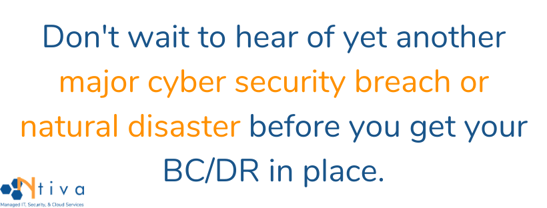How resilient do you think your business was to the recent disruption? Did you have a robust plan in place for business continuity? There certainly were mixed results as to how well companies performed!
Unfortunately, it often takes a major incident to convince businesses that they need a robust business continuity and disaster recovery (BC/DR) program in place.
As a Managed IT Services provider, we were definitely in the thick of things when everyone had to make the sudden transition to remote working. Not every company was prepared, despite access to IT expertise well before the disaster occurred.
Of course, few organizations had experienced this level of disruption before, and many small business simply didn't feel that they had the time or the money to create and maintain a business continuity plan.
But now is the time to review your operations! Ask yourself these questions:
- What would you do differently today if you knew you were going to experience another major outage in the near future?
- Did you have a documented business continuity plan?
- If yes, did the plan go as smoothly as you wanted?
- Do you have plans to change how you operate now and in the future?
What is a Business Continuity Plan?
Many people confuse disaster recovery with business continuity.
Disaster Recovery (DR) is the process of getting your IT infrastructure and operations up and running following an outage, and typically consists of a documented recovery strategy for your company's data.
Business Continuity (BC) is a holistic plan for getting the entire business back to full functionality after a crisis. It includes a detailed set of procedures for maintaining business functions in the event of a major disruption, including all the resources that will be needed to carry out your recovery strategy.
It should cover business processes, assets, human resources, business partners and more, depending on the size and complexity of your organization. Your DR plan is just one part of a complete business continuity plan.
A mature business continuity plan is actually more of a program than a plan. To give your company the best chance for success during a disaster, you need a current and regularly tested plan in the hands of the people responsible for carrying out any part of the plan.
In other words, you should have a dedicated team who is charge of the planning and management of your plan!

Why is Business Continuity Planning Important?
Think of it this way.
During a business disruption such as a fire, flood or cybersecurity attack, you might have the ability to quickly recover your business data. A very important first step!
But do you have a way to get your HR, manufacturing and sales and support functions up and running so the company can continue to make money after a disaster?
What is the process and procedures for making this happen? There are many business functions which need to be considered beyond restoring your IT.
Every organization should understand the processes within their business and the impact of the loss of those processes over time. The losses could be financial, legal or regulatory, adversely affecting market value or client confidence.
4 Steps for A Successful Business Continuity Plan
Business continuity management should not be taken lightly. There needs to be continual oversight to ensure that the plan is kept up to date.
Critical business functions are at stake, and you need to be able to function should the worst occur!
As an example, an IT services provider such as Ntiva is relied upon by hundreds of organizations for critical technology services and support 24-7-365 days a year. You can be sure we have a robust BC/DR plan in place, as well as a tightly managed program that ensures our plan is tested, maintained and ready to go at all times.
To ensure the success of YOUR information technology BC/DR program, consider these four pillars of success:
1. Management Buy-In
Imagine your IT department sitting around a conference room for the weekly check-in meeting. Next on the agenda: a continuity audit.
Who will be raising their hand to volunteer to lead that task? You might find a lot of side glances until someone finally gives in and adds it to the to-do list.
Management buy-in and funding will be essential to ensuring that the program is always at its best.
If this doesn't seem plausible in your current budget, consider looking into co-managed IT, which allows an outsourced specialist staff to work with your current team, often saving money in the long run.
Senior leaders must ensure that this is not a checkmark on a list, but a strategy that ensures the overall success of the company.
It is not one and done, but something that they will invest in continually.
2. Accountability
If the team or person responsible for continuity planning is required to provide status reports on a regular basis, they are more likely to ensure the plan is up to date.
That way no one can hide the fact that they haven’t completed an audit, data backups, or documentation on BC/DR.
If you are using a third party to provide the service, hold them accountable as well.
3. Prioritization Based on Business Impact
When it comes to business operations, nothing is created equal. Continuity planning should be impact driven, meaning resources should be allocated based on the degree of business interruption in the event of a disaster.
Budgets and resources aren’t unlimited, so be sure to place more attention on what poses a greater risk and divvy up the remaining money, planning, and time.
4. Continuity
Your BC/DR plan should constantly be monitored and updated.
The most important part of a BC/DR program is to have one! That way there are continuous efforts to ensure the plan is current and will actually do what it is supposed to in the event of a disaster or outage.
Regular reviews and updates are fundamental in keeping the business running when sub-optimal situations arise.
Don't Wait for the Next Disaster
Don't wait to hear of yet another major cyber security breach or a natural disaster before you get your BC/DR in place. Reach out to us if you want more information on how we can assist you to get your BC/DR program off the ground.
If you are an existing Ntiva client, give your Account Manager a call to discuss your needs!
You might also want to check out our technology playbook, "From Surviving to Thriving" which provides in-depth advice on how to move from the recent disruption to a more efficient and resilient business in 2020 and beyond.





